Country
Profiles
Country
Networks
Country
Associations
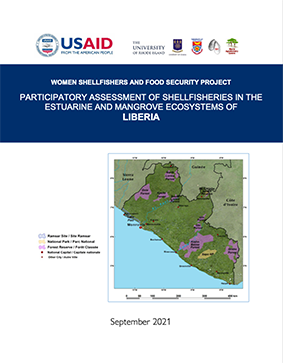
Participatory Assessment of Shellfisheries in the Estuarine and Mangrove Ecosystems of Liberia
Participatory Assessment of Shellfisheries in the Estuarine and Mangrove Ecosystems of Liberia
on Feb 2024
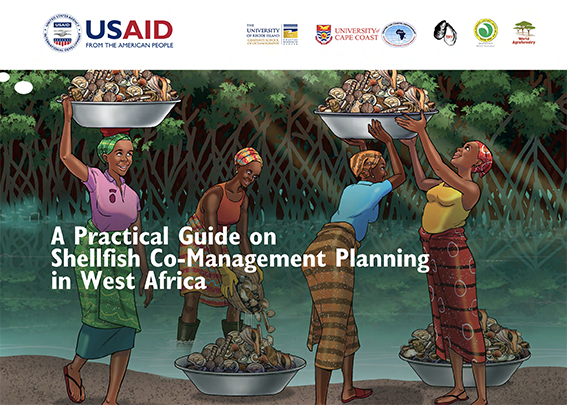
A Practical Guide on Shellfish Co-Management Planning in West Africa [ENGLISH]
This booklet is designed to provide practical guidelines on the steps for the planning of co-management in the Shellfisheries of West Africa. It is an illustrative version of a comprehensive toolkit "Empowering Women for Shelfish Management, Food Security and Biodiversity Conservation in Estuarine Ecosystems of West Africa" developed under the first Phase of the Women Shellfishers and Food Security Project. Find the toolkit online at https://pdf.usaid.gov/pdf_docs/PA00ZHT6.pdf.
on Jan 2024
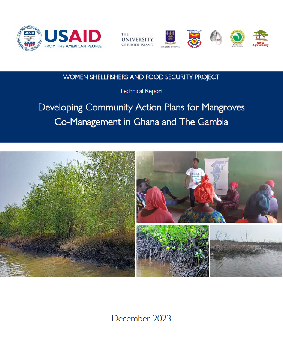
Developing Community Action Plans for Mangroves Co-Management in Ghana and The Gambia
Community Action Planning seeks to strengthen capabilities of people to come up with relevant actions aligned to their situation, resources, problems, capacities and needs of communities (Sola et al. 2017; UNDP u.d, TCCO 1995). Community Action Plans (CAPs) provide a roadmap for implementing the activities that are decided by the community itself. It can therefore serve as a framework for change and strengthen well-being, as it offers a guiding principle for implementing programs with multi-stakeholder engagement. In collaboration with implementing partners, DAA, UCC and TRY, ICRAF conducted CAP activities in the Densu and Narkwa in Ghana, and Bulock and Tanbi/Lamin in The Gambia. This work builds on the Women’s Shellfishers and Food Security project Phase I, whereby ICRAF used a visioning approach to engage communities in these sites, to reflect on their situation and aspirations for the land-seascape domains (Duguma et al. 2022a; Duguma et al 2022b). As a tool to design community development interventions, CAPs help to identify (1) what will be done; (2) who will do it; and (3) how it will be done. During this current phase of the project implementation, the objectives of interlinked activities on mangrove ecosystems restoration and conservation are to: 1) Appraise priority challenges and solutions to develop mangrove conservation, restoration, and food portfolios. 2) Develop community owned action plans to improve shellfisheries, mangrove ecosystems, and food security. 3) Conduct participatory mapping of project areas of influence and activities as they relate to mangrove use and management. 4) Provide technical support on nursery development, and mangrove and other tree germplasm acquisition to support mangrove restoration and conservation.
on Dec 2023
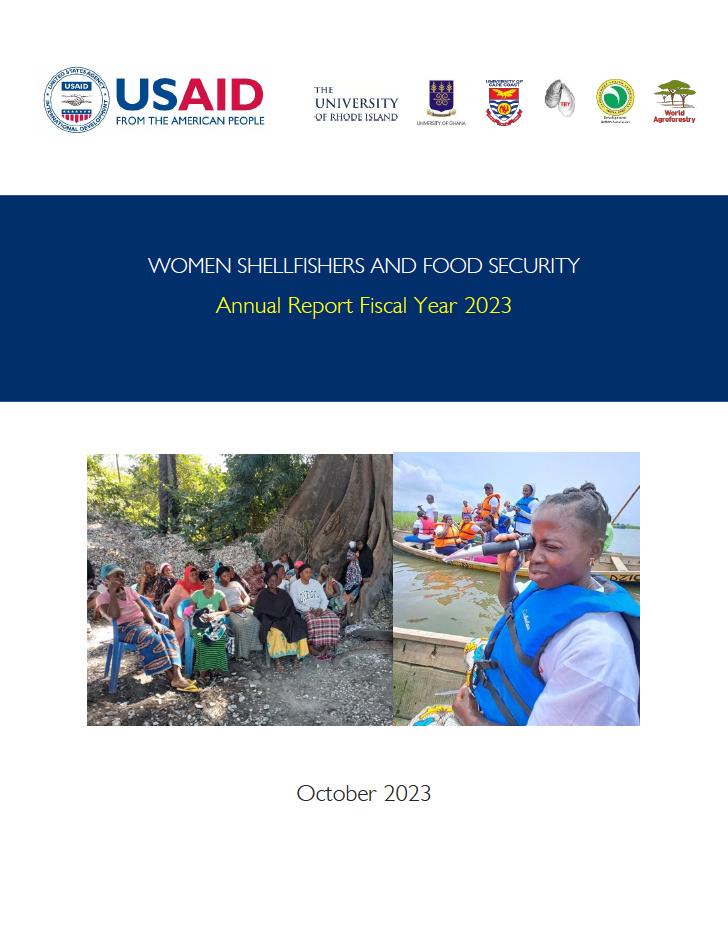
2023 Annual Report: Women Shellfishers and Food Security Project
This report documents progress on project implementation at the end of the first year of the three-year extension (FY23), October 2022 – September 2023. (Phase II of the Women Shellfishers and Food Security Project).
on Oct 2023
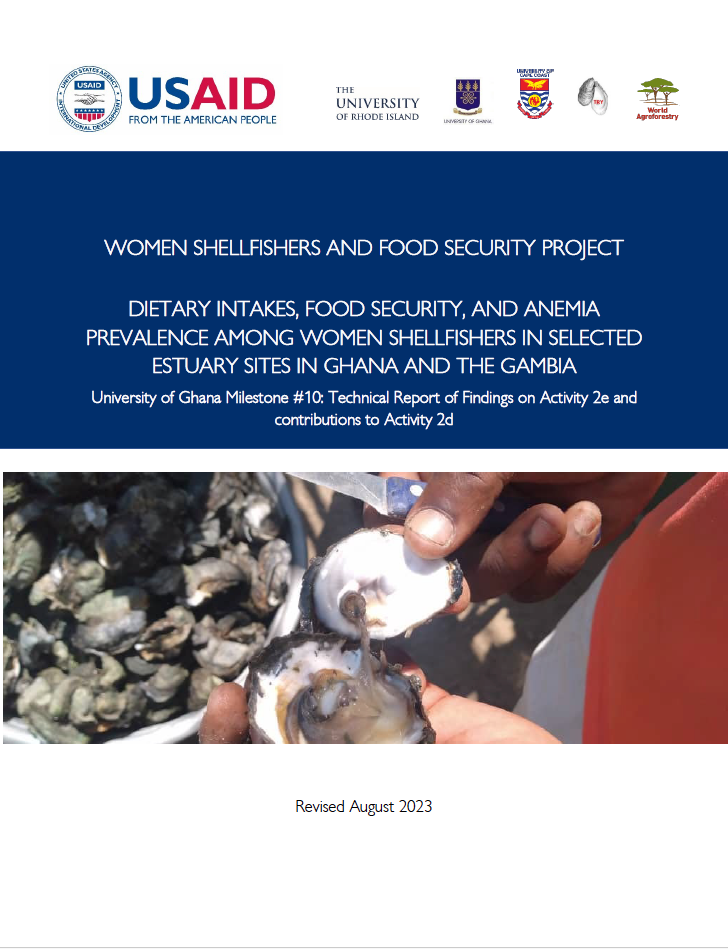
Dietary Intakes, Food Security and Anemia Prevalence Among Women Shellfishers in Selected Estuary Sites in Ghana and The Gambia
Oyster shellfishing offers a rich source of iron and other nutrients for women shellfishers in Ghana and The Gambia, where anemia prevalence among women remains high. Success at oyster shellfishing depends on appropriate management of local shellfisheries resources. In estuarine communities where the local shellfisheries resources are poorly managed, decreased oyster yields and availability could deny women shellfishers of a potentially vital resource for income and the prevention of household food insecurity, low dietary diversity, and anemia. We aimed to compare nutritional outcomes among women shellfishers 15-49 years of age living at three estuary sites in Ghana and The Gambia. We hypothesized that within each country, lower household poverty and higher oyster consumption (potentially resulting from increased oyster yields due to improved management of shellfisheries resources) would be associated with: (a) lower household food insecurity, (b) greater likelihood of achieving minimum dietary diversity for women (MDD-W), and (c) lower prevalence of anemia. In addition, we aimed to determine the mineral and heavy metal concentrations of oysters collected from three estuarine sites in Ghana and evaluate whether heavy metal contamination is of concern to the health of women shellfishers at these sites.
on Aug 2023
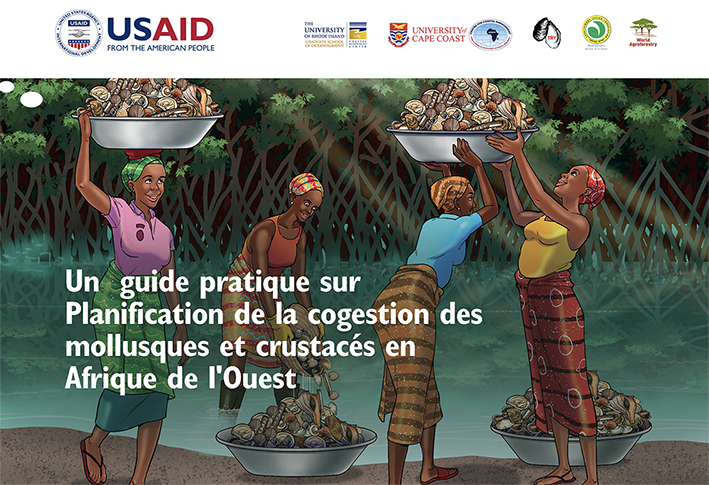
Un guide pratique sur Planification de la cogestion des mollusques et crustacés en Afrique de l'Ouest [FRENCH]
Cette brochure est conçue pour fournir des lignes directrices pratiques sur les étapes de planification de la cogestion des pêcheries de mollusques e t crustacés d'Afrique de l'Ouest. Il s'agit d'une version illustrative d'une boîte à outils complète "Autonomiser les femmes pour la gestion des mollusques et crustacés, la sécurité alimentaire, et la conservation de la biodiversité dans les écosystèmes d'estuaires d'Afrique de l'Ouest" développé dans el cadre de la première phase du projet Femmes pêcheurs de mollusques et crustacés et sécurité alimentaire. Retrouvez la boîte à outils en ligne sur https://pdf.usaid.gov/pdf_docs/PA00ZHT6.pdf.
on Jun 2023
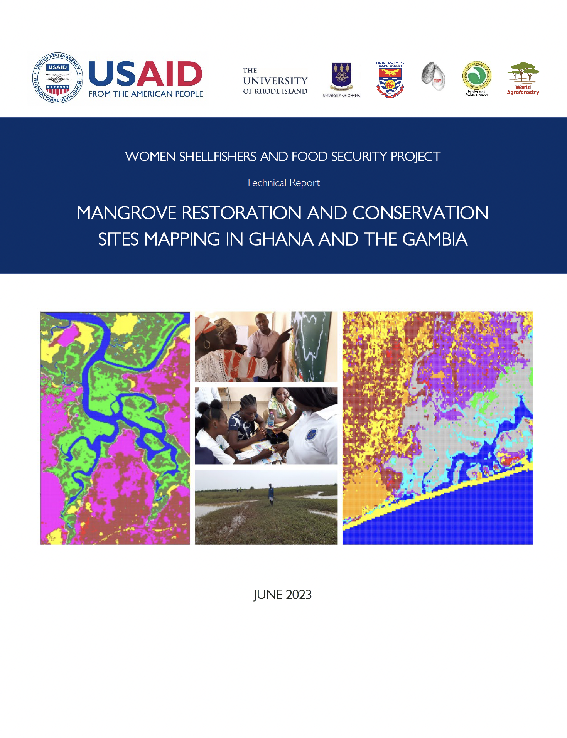
Mangrove Conservation and Restoration Sites Mapping in Ghana and The Gambia
The Women Shellfishers and Food Security Project aims to strengthen the evidence for, increase awareness of, and equip stakeholders to adapt and apply successful approaches to rights-based, ecosystem-based, participatory co-management of shellfisheries by women in mangrove ecosystems in West Africa. The broad goal of the project is to “Foster the adoption and scaling-up of an integrated approach to conservation and restoration of mangrove and estuarine ecosystems in West Africa that provides cross-sectoral benefits in terms of gender equality and women’s empowerment, economic development, and household food resiliency” (USAID 2022). The project is funded by USAID, and implemented by the University of Cape Coast (Ghana), Development Action Association (DAA), TRY Oyster Women’s Association (TRY), World Agroforestry (ICRAF) and University of Rhode Island (URI). To achieve the goal of the project, ICRAF conducted mangrove restoration and conservation site mapping in Narkwa and Densu in Ghana, and Bulock and Lamin in The Gambia. This was part of Output 1.3 of the project to Develop mangrove co-management, and specifically Output 1.3.1 on Mangrove restoration sites mapping covering the four project sites. This report provides details on Geographic Information System (GIS) mapping work, which involved participatory GIS mapping with communities across the four sites, and featured ‘ground truthing’ and related accuracy assessments. This work was conducted beginning in January 2023 in the four sites, and builds on the findings of field work at these sites conducted during Phase I of the project in 2021 and 2022.
on Jun 2023
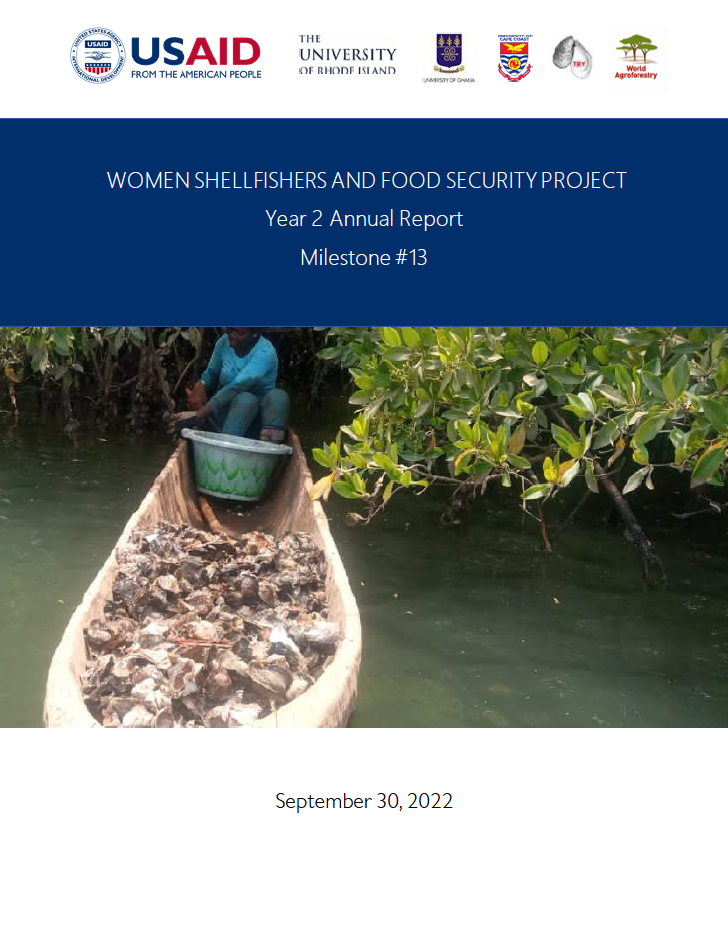
2022 Annual Report: Women Shellfishers and Food Security Project
This report documents project achievements at the end of Year 2, September 15, 2021 – September 14, 2022, of this two-year project that began on September 15, 2020 and is completing its two-year first phase.
on Sep 2022
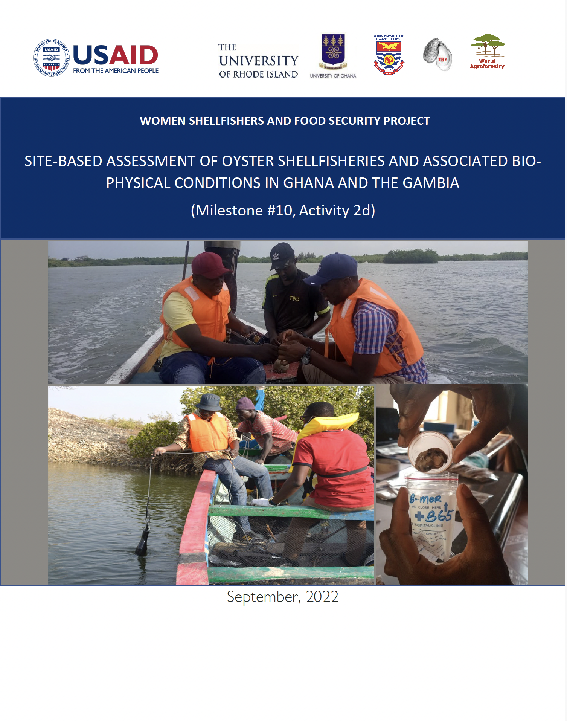
Site Based Assessment of Oyster Shellfisheries and Biophysical Conditions in Ghana and The Gambia
This is a technical report on the site-based research under Activity 2d of the Women Shellfishers and Food Security Project. Activity 2d involved a one-year study of shellfisheries, shellfish biology, and physicochemical analysis of water within six estuarine and mangrove ecosystem-based livelihoods sites, three each in Ghana and The Gambia. Field data collection commenced in March 2021 and ended in March 2022, while laboratory processes continued to the end of May 2022, and results are presented in this report. Monthly data collection on physico-chemical properties of the estuaries (depth, temperature, salinity, dissolved oxygen, pH, and turbidity) were conducted at all six sites. Quarterly data collection on nutrients (phosphates and nitrates), microbial loads (total coliform, fecal coliform, and E. coli), and heavy metals (Pb, Hg, As, Cr, and Cd) in both water and oyster flesh, were executed at all sites. Biometric data (shell heights, shell lengths, whole weight, shell weight, meat weight, and dry weight) on oyster samples was collected every month for all six sites. Sex determination by visual observation and histological processes was conducted on oyster specimens from all six sites. In addition to these biological and ecological studies, two separate social surveys, one on the socioeconomics of shellfishing households and another on oyster fishery were conducted in the adjoining communities of the six sites. Further studies on the oyster exploitation were also conducted by collecting the catch and effort data at each site.
on Sep 2022
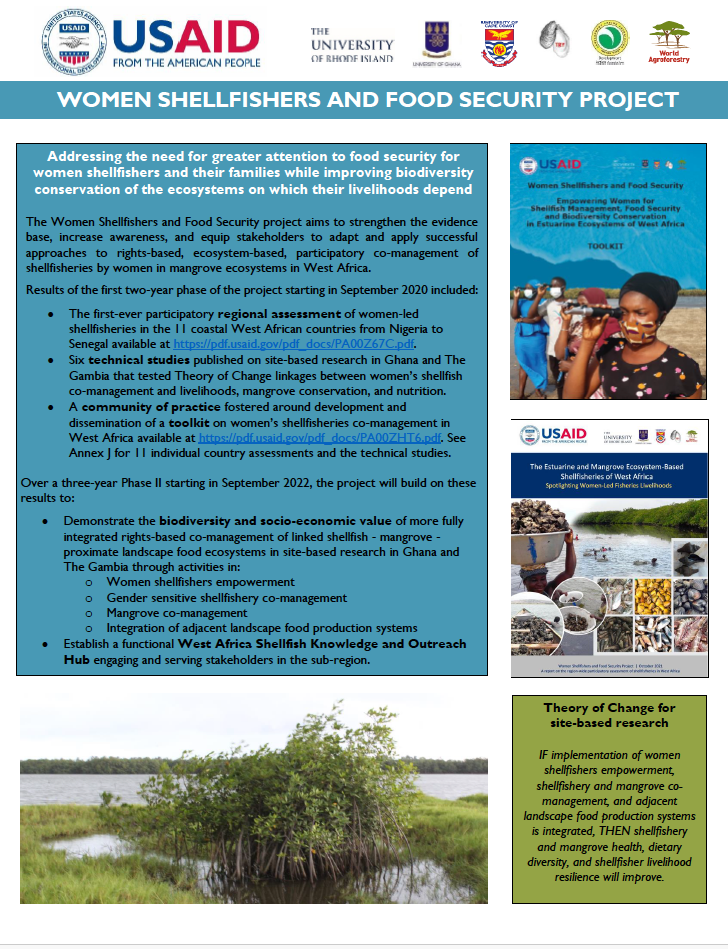
Fact Sheet: Women Shellfishers and Food Security Project (Phase II)
The Women Shellfishers and Food Security project aims to strengthen the evidence base, increase awareness, and equip stakeholders to adapt and apply successful approaches to rights-based, ecosystem-based, participatory co-management of shellfisheries by women in mangrove ecosystems in West Africa.
on Sep 2022
